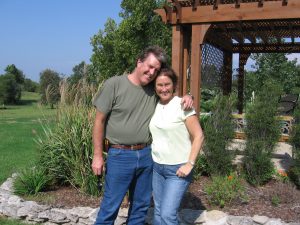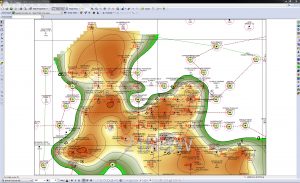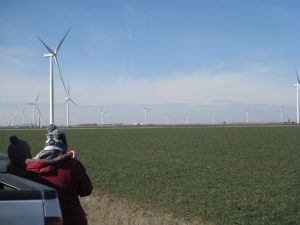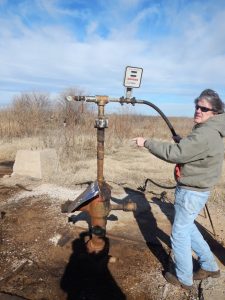Robert “Bob” Von Rhee – 1975
A Long Island, New York Kid Goes West

Bob Von Rhee at a Pumping Well
I entered Lafayette College in 1971, the second year it was actually coed. Growing up in Massapequa, NY, I knew in high school, that I wanted to study a natural science of some kind at college. So I entered as a physics major since I had enjoyed that class in high school. However by about the end of October my first semester, I realized that physics was not really my thing. I had the luxury in my freshman year to take electives and my first elective was a newly offered class on Oceanography (another interest of mine) given by Dr. Dick Faas, the geology chairman. The class was big for LafCol standards at the time, about 50 students and I was taken by surprise one evening as I passed Van Wickle on my way to the dining hall (it was Marquis Hall back then). Dr. Faas was just leaving the building and his path merged with mine and he called out “Hey Bob!” I didn’t react at first but then realized he was calling me. He wondered how I thought I had done on our recent hour exam in oceanography? This made an impression on me in two ways – first, he actually knew my name out of a very large class and I had not ever spoken to him except to raise my hand in class. Second, here was the “Chairman” of a department just shooting the breeze with me, a lowly freshman! This impression stayed with me and became significant.
I enjoyed oceanography and took another new course in the spring “Environmental Geology” and as the end of my freshman year drew near, I knew I had to figure out a major, and physics was not it. I decided to visit with both the Biology Chairman (formal appointment required) and with Dr. Faas about “geology”. As it worked out, the Chair of Biology really wasn’t interested in me majoring if I wasn’t pre-med, and actually wondered why I wanted to study biology if I only ended up as a “lab technician”! Meanwhile the people I had met in the Geology Department and especially Dr. Faas made all the difference and I began the geology curriculum in earnest in the fall. In Geology, I felt an interest in the student as opposed to an interest in a process of turning out graduates.
While my parents wondered “What was a Geologist”, I continued my geology courses and enjoyed a particularly large group of us – 12 majors in my class. We took weekend field trips and two spring break trips, one to south Florida and another to Jamaica. Geology course class sizes were usually small and we “geo-majors” got to know our faculty well. In my view, this was, and is, one of the benefits of attending a small college that really enhances the learning experience. In my junior year, I was honored as the recipient of the James Dyson scholarship helped me attend Princeton’s summer field camp at the Yellowstone Bighorn Research Association (YBRA) in Montana. Although apprehensive about how I would stack up against undergrads and graduate students from larger universities and colleges, I discovered I had as good a geological foundation from my Lafayette courses as anyone at the camp. In my opinion all geology majors should attend a field camp if possible. I think my field camp experience proved invaluable as I pursued a senior thesis project mapping some of the glacial deposits in northern New Jersey.
Although I did not join a living group while at Lafayette (19 fraternities when I enrolled as I recall!), I maintained a close group of friends and we were able to usually room together or in close proximity each year. I and a close friend played guitar and for two years, performed at campus fraternity parties and were for a time, regular entertainment at a bar over in Phillipsburg (legal age was 18). Lots of fun and good times.
I was asked if there was a transformative experience for me while at Lafayette. Although there were dozens of “experiences” during my college days, the one that immediately came to mind when I read this was another informal meeting with Dr. Faas in Van Wickle one evening. We crossed paths and in answer to “how’s it going Bob” I began to complain about taking Mineralogy. Dr. Faas had been a source of much encouragement during my path in geology, but this time his reply was something like “If you don’t think you can learn mineralogy, then you better forget about becoming a geologist.” Well shut my mouth! I never complained about the course again, realizing that he was exactly right and my copy of Deer, Howie and Zussman remains on my bookshelf to this day, totally marked up as I’ve continued to refer to it throughout my career!
Although we see more geologists in the media today, I think the profession remains rather opaque to most folks. Indeed this was the case upon my Lafayette Graduation. No geologic job postings back then. With no specific career path but with guidance from the department, I pursued graduate school, eventually getting my Master’s degree from the University of Illinois. I was funded by a teaching assistantship which required me to teach certain lab classes and assist in other courses. My interest in sedimentology and glacial geology led to a Master’s thesis in resedimented glacial till. Three graduate courses I took at this time turned out to be very important in my career as a petroleum geologist although I didn’t realize it at the time. Sedimentary Petrology, Hydrology, and Clay Mineralogy all have been invaluable as I study oil and gas reservoirs. At some level, hydrocarbon reservoirs are essentially aquifers with multiple fluids and phases and at much higher pressures and depths. Understanding clay minerals and their diagenetic processes is another asset in working in the subsurface.

Bob and Pam at home
My goal in graduate school was to find employment in the geotechnical field and in the northeastern US if possible. I thought this would be a good application of my interest in sediments and glacial geology. We are all “sooo” smart when we’re young right? In the fall of my second graduate year and with the need for employment looming at the end of the academic year, I had avoided nearly all of the 8 or 10 major companies that were interviewing at the department. I had the rather naïve notion that large major oil companies would not be rewarding to work at. However, my hundreds of inquiries for geotechnical employment had only yielded three interviews without definite job opportunities. A quick look around, showed two major oil and gas companies still left, so I signed up. Let’s just say my wife may have had some influence on me at this time! In the end, I was offered a job as a Development Geologist with Exxon in Midland Texas which I accepted and so began a career in a new, unexpected path. By the way, one of the benefits of working in a large company was that my in-house training while at Exxon was the contact-hour equivalent of another 10 full semester college courses.
Today my job would be called an “Exploitation Geologist” one who studies discovered oil and gas fields in detail, integrating geology and petroleum engineering to recover the maximum amount of oil and gas economically possible. I’ve never looked back. Unfortunately industries based on commodities are inherently volatile and I lost my position in 1986 the result of a merger in the midst of collapsing crude oil prices. The good news is that recovering from this event as a consulting geologist focused my skills and technical strengths as never before and I believe I am a better professional today because of it. I’ve made lifelong friends and acquaintances and benefited from working with some teams of extremely talented folks. The upstream oil & gas industry is actually a fairly small industry relative to the number of professionals employed in it.

Screenshot of an oil field contour map
We all know that times change and a significant change for today’s petroleum geologist is the focus on what has become the “resource” play, or extracting oil and gas from unconventional reservoir rocks. Another change is computing. The technological advances since the 1980’s now place industry-specific GIS mapping & modelling software and 3-D seismic data at every petroleum geologist’s fingertips. With these changes, I highly recommend students take courses in GIS, Geochemistry, and if possible Seismic Geophysics. And one final thought. Taking a course in economics is a very good idea. The solution to any problem usually has a cost, either monetary, trade-offs or both, and economics can provide a useful framework to formulate solutions to problems.
My first job with Exxon was actually a “boom” period in the petroleum industry during the late 1970’s and I left after a little more than 3 years to seek my fortune with an “independent” oil company. It’s since been a long, complicated trail that has fortunately ended well for me and my family. Here in Tulsa, I am part owner of a small oil and gas production company, KVR Energy LLC founded in 2000. My work is as enjoyable as ever, even more so because today I can work data on the computer at more than an order of magnitude faster (and better!) than in 1977 and I can do a ton of geologic research from my desktop in just an afternoon. Today’s petroleum geologists have more data and tools to interpret these data today than ever in the history of the profession. As an applied scientist, I look forward to working each day.
At Lafayette, I had what one would call a fundamental solid education in geology which I continued in graduate school. This foundation was what I then applied specifically to petroleum geology and especially subsurface stratigraphy. Courses like physical geology, historical geology, structure, sequence stratigraphy, mineralogy, geomorphology, hydrology, petrology, carbonates-clastic depositional systems, tectonics and regional geology, calculus, physics, chemistry, English (it remains important that you know how to write!), all may come to bear on any given geological problem.
Here’s an example. In 2011, I taught a graduate-level subsurface mapping course at the University of Tulsa. The final project was mapping a 25 square mile natural gas field where the trap was a breached anticline at a depth of 18,000 feet. Erosional unconformities account for many significant hydrocarbon traps. Contrary to surface interpretation where we get to see 100% of the topographic data, there were only two or three wells per square mile across the field, so one had to draw on one’s background in geomorphology, landforms, and surficial processes make a geologically reasonable interpretation. To my surprise only two students in the entire class had taken a geomorphology course. Many struggled with how to interpret the structure between the scattered points of control.
I can imagine a similar problem if one is attempting to map and characterize the attributes of a mostly unconsolidated clastic aquifer for a groundwater or environmental problem. Perhaps these subjects would help to understand depositional geometry and internal heterogeneity of the pore system: age and depositional history of aquifer, hydrology, fluvial or mass movement depositional processes, sediment mineralogy, or maybe even vadose-phreatic low temperature lithification for a start? I think I’m way out on a limb here!
The interconnections of the specific geology courses we take during our formal education are not always self-evident when we’re in school, but they exist and often provide us the insight to perform good work in whatever geological career we pursue. One of my interests upon entering Lafayette was oceanography, and I thought I might like to become an “Oceanographer”. I discovered that there wasn’t really a degree in “oceanography”. Rather, scientists with specific training in biology or geology or meteorology were applying their expertise to the oceans. It served as a reminder to me to become founded in a certain area of expertise and apply it to interdisciplinary problems.

Viewing a wind farm
As a professional, continuing education is a given. Large companies often provide this for employees. National, regional and local professional societies are usually full of continuing education opportunities. I encourage professionals to become involved with their societies and other means to stay active in your communities. I’m a past-president of the Tulsa Geological Society along with some other volunteer committees. I also served as an alternate Tulsa delegate for the American Association of Petroleum Geologists (AAPG www.aapg.org ). I am a founding member and now past president of the Tulsa Geological Society Foundation. I had the opportunity to help design and teach a course at the University of Tulsa in Entrepreneurial Geology in 2006 and have remained a volunteer Research Associate and occasional adjunct instructor since then. One of the presentations I developed for this course became an oral presentation at the 2009 Mid-Continent AAPG convention in Tulsa. Stay involved in your community as you can. Answering a request to TU, I developed a presentation on hydraulic fracturing and have now presented to several organizations in the region, including the northeast Oklahoma chapter of the Sierra Club. Over the past several years, my wife Pam and I have been hosting two geology externships at my company during the Mid-year break. Our three-day externship attempts to introduce students to subsurface geologic interpretation, the business of producing oil and gas and a field trip to a producing oil field and Oklahoma wind farm. Our discussions are usually very broad about geology and energy in general but always very rewarding. When you listen and teach, you learn and it’s been an incredible experience of continuing education for me.
It’s been a long way from Long Island to Oklahoma by way of Pennsylvania, Illinois and Texas, but Pam and I have raised two great kids who now have five grandkids between them. We call 30 acres (on Pleistocene terrace deposits), two dogs and seven horses our home now about 25 miles outside Tulsa. Pam works for a 10,000 acre ranch located northwest of Tulsa and occasionally gets to work the cattle there – on and off horseback. I’ve been learning how to transition from my street bike to dirt bike and trail-ride with my son and grandson. Over the past 6 years, out here in the “stable” craton, we’ve now experienced four earthquakes ranging in magnitude from 5.0 to 5.8. Our upswing in seismicity here has been attributed to an extraordinary oil field play combined with a conventional produced saltwater disposal process that was taken to the extreme. But that’s another story for another day!
I was encouraged to write “a few paragraphs” for the department, and as you can see I’ve failed miserably. Geologists are in a unique position to understand many of the earth’s problems and processes better than most. We learn about “deep time” and we are trained to think of the planet and all of the processes that have shaped it and continue to do so. This perspective often enables us to see problems differently than others. We know for example that human record keeping for example represents an infinitesimally small piece of the planet’s history. I often cringe when I hear a flood victim make statements that they’ve lived there all their life and never experienced a flood so large. Of course not. A human lifetime is totally insufficient to have recorded the largest potential flood on a river. As geologists we know that. People also like to think of the earth’s surface morphology as permanent and therefore build houses along shorelines and fiver floodplains and in areas of unstable hillsides. Yet, we know that these regions are actually some of the most dynamic geological environments.

Bob at a secondary recovery injection well
All sources of energy have a place in today’s world, and oil and gas will remain a significant energy source for the foreseeable future. The transition from a fossil fuel economy to a renewable economy will take time. Working in the petroleum industry doesn’t preclude you from recycling, conserving energy, owning an electric car or hybrid, using solar to power your home, or doing your best to limit your environmental footprint. When you consider “full cycle” energy costs, all have a cost of some kind. There is no free lunch. Just review the first law of thermodynamics! But as geologists, we can have a significant role in understanding the energy the earth and sun provide and the corresponding impact on our environment.